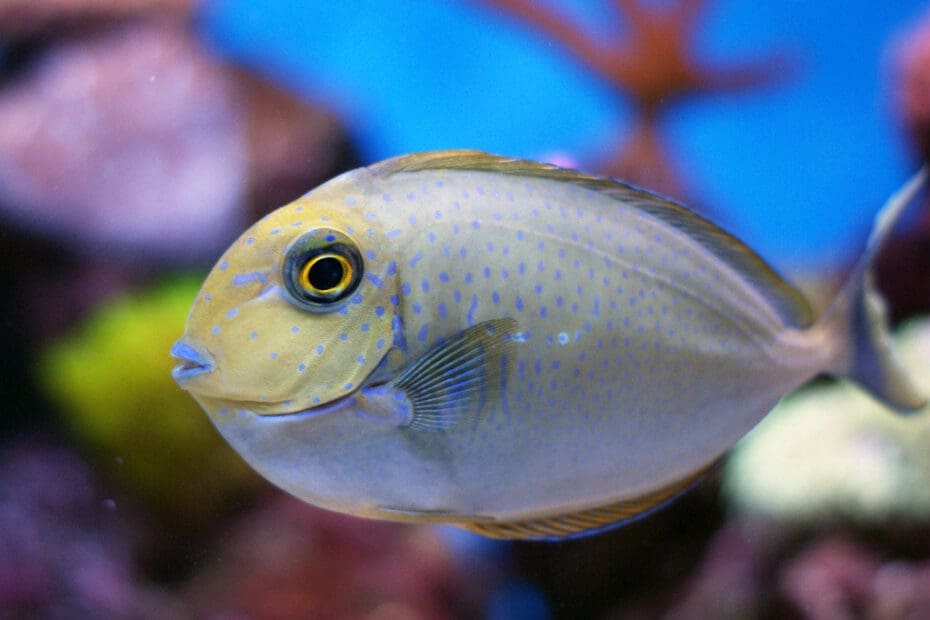Naso vlamingii (Vlamingi Tang / Bignose Unicornfish)
• Small fish safe: ✅ Yes
• Small invert safe: ✅ Yes
• Coral safe: ✅ Yes
• Minimum tank size: 800L+ (preferably 1000L+)
• Adult size: ~60 cm
• Diet: Herbivorous (marine algae, seaweed, spirulina-based flakes/pellets, occasional meaty foods)
• Be aware of: Requires a very large tank due to its rapid growth and constant swimming. Generally peaceful but can become territorial as it matures. Needs a high-fiber diet to prevent digestive issues.
Vlamingi Tang (Naso vlamingii) – A Large, Active, and Intelligent Surgeonfish
The Vlamingi Tang, also known as the Bignose Unicornfish, is a large, highly active tang species found in the Indo-Pacific region. It belongs to the Naso genus, which includes species that grow considerably larger than most other tangs. With its distinct coloration, changing patterns, and friendly nature, this species is a favourite among large marine aquarium enthusiasts—though it requires a very spacious tank to thrive.
Appearance and Coloration
Juvenile Vlamingi Tangs are typically grayish-blue with subtle hints of patterning. As they mature, their colour and markings change dramatically, with adult specimens developing an iridescent blue-green body with dark spots and patches. The face is adorned with intricate markings, and their lips often take on a vibrant blue hue.
One of the most fascinating aspects of this species is its ability to change colour based on mood, environment, and breeding conditions. A relaxed Vlamingi Tang may appear dull, while an excited or dominant individual will display intense blues, greens, and purples.
Size and Growth Rate
Vlamingi Tangs are one of the largest tang species, reaching up to 60 cm (24 inches) in length. They grow rapidly, often outgrowing tanks that are too small within a few years. Because of their size and activity level, they are best suited for public aquariums or extremely large home setups.
Natural Habitat and Behaviour
In the wild, Vlamingi Tangs inhabit deep lagoons, coral reef slopes, and open ocean areas, where they are often seen swimming in small schools or loose groups. They are constant grazers, feeding on algae-covered rocks and reef surfaces throughout the day.
They are also known for their high intelligence and social behaviour. Unlike some other tangs, they often develop a friendly bond with their owners, even recognizing the person who feeds them.
In captivity, they require plenty of open swimming space and strong water flow to replicate their natural environment. While generally peaceful, larger individuals may become territorial over time, especially if housed with other large tangs.
Tank Requirements and Water Parameters
Because of their size and swimming needs, Vlamingi Tangs require one of the largest tank setups of any tang species.
• Minimum tank size: 800L+ (1000L+ recommended for adults)
• Temperature: 23–26°C
• pH: 8.1–8.4
• Salinity: 1.020–1.025
• Water movement: Moderate to strong
• Filtration: High-capacity filtration and protein skimming due to their large size and diet
• Tank length: At least 8 feet (2.4m) for adult specimens
They are best suited for very large reef or FOWLR (Fish Only With Live Rock) tanks. Live rock is essential for natural grazing, and open swimming areas are a must.
Diet and Feeding
Vlamingi Tangs are primarily herbivores, grazing on macroalgae and seaweed in the wild. However, they are also known to consume some meaty foods. A varied diet is essential to maintain their health, colour, and longevity.
Recommended foods include:
• Dried seaweed (Nori) – Essential for digestive health
• Spirulina-based flakes and pellets – Provides necessary vitamins and nutrients
• Fresh macroalgae – Such as chaetomorpha or gracilaria
• Occasional meaty foods – Enriched brine shrimp, mysis shrimp (not a staple)
Due to their large size and high metabolism, Vlamingi Tangs should be fed multiple times daily—at least 2-3 times per day. A fiber-rich diet is crucial to prevent digestive blockages and HLLE (Head and Lateral Line Erosion).
Compatibility and Tank Mates
Vlamingi Tangs are generally peaceful, making them excellent community fish for large tanks. However, due to their size and constant movement, they should only be housed with fish that can tolerate their activity level.
Best tank mates include:
✔ Large angelfish (Emperor Angelfish, French Angelfish)
✔ Other large, peaceful tangs (Naso Tangs, Sailfin Tangs)
✔ Wrasses (Harlequin Tusk, Bird Wrasse)
✔ Groupers and larger reef-safe fish
Avoid housing with:
❌ Very aggressive fish (e.g., Triggerfish, aggressive Eels)
❌ Small, timid species that may be outcompeted for food
❌ Other Naso tangs in smaller setups (can cause territorial disputes)
Health and Disease Considerations
Vlamingi Tangs are relatively hardy, but they are still susceptible to marine ich (Cryptocaryon irritans), HLLE, and other stress-related diseases. To ensure their long-term health:
• Quarantine new specimens before introducing them to the display tank.
• Provide a high-fiber diet to prevent nutritional deficiencies.
• Maintain strong water flow and high oxygenation to reduce stress.
• Keep stable water parameters—fluctuations can make them prone to disease.
With proper care, Vlamingi Tangs can live up to 15 years or more, making them a long-term commitment for dedicated aquarists.
Lifespan and Long-Term Care
Due to their rapid growth, large adult size, and high activity levels, Vlamingi Tangs are not recommended for beginner aquarists or those with small tanks. They are best suited for large marine systems, public aquariums, or aquarists with extensive experience in tang care. If provided with a large, well-maintained habitat, they will thrive and become an interactive, engaging member of the tank.
